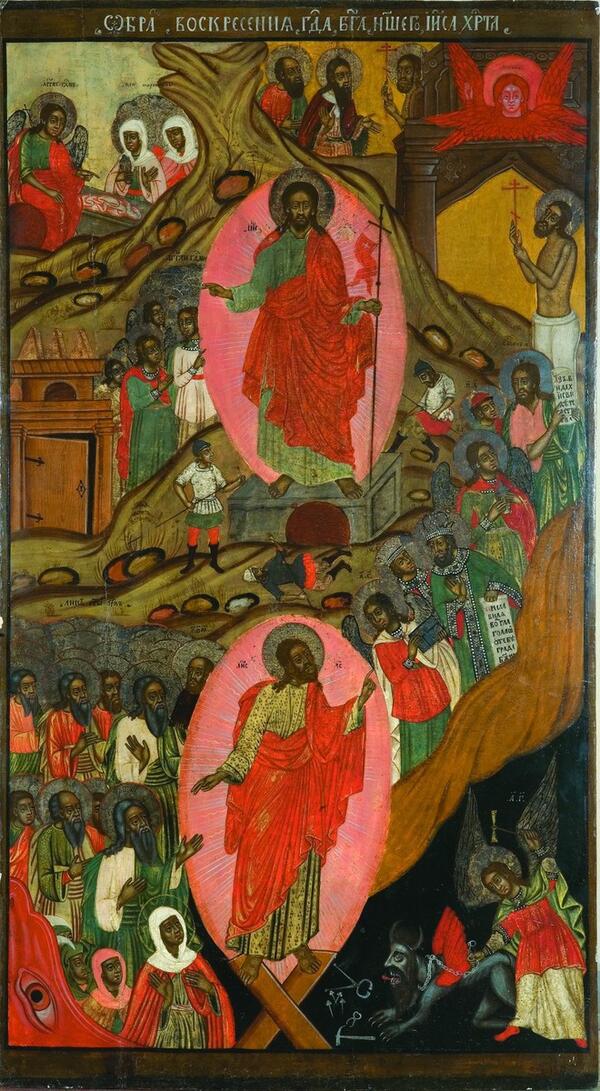None of the evangelists described the main event of the New Testament — the Resurrection of Christ. For a long time, the icon painters did not depict the events of the Easter, which were rendered solely in a symbolic way. For example, the story of Jonah’s three-day stay in the belly of a whale, featured by the frescoes of the Roman catacombs, symbolized the Resurrection of Christ on the third day. The image of the guards sleeping at the tomb, as well as the depiction of an angel appearing to the myrrh-bearing women could indicate that this is the scene of Christ’s resurrection.
The final composition of the ‘Harrowing of Hell’, illustrating the salvation of the humankind, developed only by the 11th century. The iconography is based on a highly complicated narrative, which includes the texts from the Old and the New Testament, the teachings of the Church Fathers that influenced the liturgical texts used in the celebration of the feast, as well as the Gospel of Nicodemus that is considered apocryphal. According to these writings, after sacrificing himself on the cross, the Lord descended into hell and led Adam and Eve, the parents of the human race, together with all the righteous out.
The Byzantine and Old Russian icon painters never portrayed the very moment of the Resurrection. Instead, they used the composition of the Harrowing of Hell, which had a double name — ‘Harrowing of Hell — Resurrection of Christ’. From the second half of the 17th century, Russian icon painters began to depict the Resurrection of Christ in one more way adopted from the Western European engravings. In this iconographic type, Christ comes out of the tomb carrying the banner of victory. When these two traditions were combined, a new original composition emerged. It depicts the events in their sequence and is enhanced with new scenes as well as participants, such as the sleeping warriors, the Penitent Thief Rakh, the Myrrhbearers.
The icon from the museum collection belongs to the latter version of depicting the Resurrection of Christ. The composition is traditionally diagonal: Christ is in the center, flanked by Adam and Eve in a white dress, the righteous, the patriarchs, the prophets. They can be easily recognized — among them are John the Baptist, King David, King Solomon, and Moses with the tables of the law.
The faces are rendered in a ‘true-to-life’ manner — they are soft, warm, tangible. This style can be traced back to the art of the Kremlin Armory icon painters. The color palette scheme is based on the combination of red, green, and brown shades. Gs used to draw the folds of the clothes using thin gold lines. The scenes are separated by undulating hills depicted as boulders — the main landscape motifs in icon painting. There is scarce shrubbery and a small pine tree. Above is the image of the Paradise surrounded by a wall.
The final composition of the ‘Harrowing of Hell’, illustrating the salvation of the humankind, developed only by the 11th century. The iconography is based on a highly complicated narrative, which includes the texts from the Old and the New Testament, the teachings of the Church Fathers that influenced the liturgical texts used in the celebration of the feast, as well as the Gospel of Nicodemus that is considered apocryphal. According to these writings, after sacrificing himself on the cross, the Lord descended into hell and led Adam and Eve, the parents of the human race, together with all the righteous out.
The Byzantine and Old Russian icon painters never portrayed the very moment of the Resurrection. Instead, they used the composition of the Harrowing of Hell, which had a double name — ‘Harrowing of Hell — Resurrection of Christ’. From the second half of the 17th century, Russian icon painters began to depict the Resurrection of Christ in one more way adopted from the Western European engravings. In this iconographic type, Christ comes out of the tomb carrying the banner of victory. When these two traditions were combined, a new original composition emerged. It depicts the events in their sequence and is enhanced with new scenes as well as participants, such as the sleeping warriors, the Penitent Thief Rakh, the Myrrhbearers.
The icon from the museum collection belongs to the latter version of depicting the Resurrection of Christ. The composition is traditionally diagonal: Christ is in the center, flanked by Adam and Eve in a white dress, the righteous, the patriarchs, the prophets. They can be easily recognized — among them are John the Baptist, King David, King Solomon, and Moses with the tables of the law.
The faces are rendered in a ‘true-to-life’ manner — they are soft, warm, tangible. This style can be traced back to the art of the Kremlin Armory icon painters. The color palette scheme is based on the combination of red, green, and brown shades. Gs used to draw the folds of the clothes using thin gold lines. The scenes are separated by undulating hills depicted as boulders — the main landscape motifs in icon painting. There is scarce shrubbery and a small pine tree. Above is the image of the Paradise surrounded by a wall.



